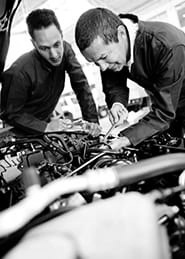Profession automotive engineering technician

Car mechanics repair, maintain and service (components of) vehicles
Would you like to know what kind of career and professions suit you best? Take our free Holland code career test and find out.
Personality Type
Tasks automotive engineering technician
- Examine vehicles to determine extent of damage or faults and to estimate repair costs.
- Confer with customers to obtain descriptions of vehicle problems, and to discuss work to be performed.
- Inspect vehicles ensuring all important parts are examined, including belts, hoses, steering systems, spark plugs, brake and fuel systems, wheel bearings, etc.
- Test components and systems, using suitable equipment such as compression gauges.
- Plan work procedures.
- Repair, replace or adjust worn and faulty parts using suitable tools and equipment.
- Perform routine and scheduled maintenance services such as oil changes, lubrications, etc.
- Test and adjust repaired parts or assemblies to make sure they work properly.
- Carry out minor body and trim repairs.
Related professions cars
- Automotive body repairer
- Automotive glass installer or repairer
- Bus mechanic
- Car seller
- Car tyres mechanic
- Cars and other vehicles inspector
- Diesel engine mechanic
- Engineering maintenance supervisor
- Garage receptionist
- Garage supervisor
- Motor-vehicle engine fitter
- Motorcycle mechanic
- Rental clerk road or water vehicles
- Road vehicles loader
- Truck mechanic
- Vehicle patrolman/woman
- Vehicle spray painter
- Vehicle upholsterer
Knowledge
- Mathematics
Mathematics is the study of topics such as quantity, structure, space, and change. It involves the identification of patterns and formulating new conjectures based on them. Mathematicians strive to prove the truth or falsity of these conjectures. There are many fields of mathematics, some of which are widely used for practical applications.
- Mechanics
Theoretical and practical applications of the science studying the action of displacements and forces on physical bodies to the development of machinery and mechanical devices.
- ICT software specifications
The characteristics, use and operations of various software products such as computer programmes and application software.
- Mechanics of motor vehicles
The way energy forces interact and affect components in motor vehicles such as cars, buses, invalid carriages and other motorised vehicles.
- Multimedia systems
The methods, procedures and techniques pertaining to the operation of multimedia systems, usually a combination of software and hardware, presenting various types of media such as video and audio.
- Vehicle manufacturing process
Series of steps taken in order to produce a car or any other motor vehicle such as the design, the chassis and body assembly, the painting process, the interior assembly and the quality control.
- CAE software
The software to perform computer-aided engineering (CAE) analysis tasks such as Finite Element Analysis and Computional Fluid Dynamics.
- Material mechanics
The behaviour of solid objects when subjected to stresses and strains, and the methods to calculate these stresses and strains.
- Engineering processes
The systematic approach to the development and maintenance of engineering systems.
- Engineering principles
The engineering elements like functionality, replicability, and costs in relation to the design and how they are applied in the completion of engineering projects.
- Physics
The natural science involving the study of matter, motion, energy, force and related notions.
Skills
- Execute analytical mathematical calculations
Apply mathematical methods and make use of calculation technologies in order to perform analyses and devise solutions to specific problems.
- Use a computer
Utilise computer equipment or digital devices to facilitate quality control, data management, and communication. Follow instructions given by a computer programme, create computer files or documents.
- Adjust engineering designs
Adjust designs of products or parts of products so that they meet requirements.
- Read standard blueprints
Read and comprehend standard blueprints, machine, and process drawings.
- Read engineering drawings
Read the technical drawings of a product made by the engineer in order to suggest improvements, make models of the product or operate it.
- Troubleshoot
Identify operating problems, decide what to do about it and report accordingly.
- Liaise with engineers
Collaborate with engineers to ensure common understanding and discuss product design, development and improvement.
- Recommend product improvements
Recomend product modifications and process improvements.
Optional knowledge and skills
assess operating cost ensure equipment availability record test data airport safety regulations maintain vehicle electrical equipment check functionality of essential components of airport vehicles maintain snow removal equipment cad software manage supplies electrical engineering order supplies determine maintenance schedules for airport equipment write stress analysis reports guidance, navigation and control perform test run maintain electrical engines operate precision measuring equipment disassemble equipment product data management perform physical stress tests on models manage airport vehicle licences use cadd software keep records of work progress disassemble engines electronics principles synthetic natural environment perform maintenance on installed equipment re-assemble engines ensure compliance with airport security measures manage airport workshops plan manufacturing processes use cad software determine production feasibility design drawings follow production schedule operate testbeds inspect data defense system cadd software perform tests on airport vehicles manage health and safety standards keep airport maintenance equipment in suitable condition analyse stress resistance of products use testing equipment write inspection reports identify airport safety hazards perform preventive maintenance on fire fighting vehicles position engine on test stand follow manufacturer guidelines in use of airport equipment aerodynamics calibrate electronic instruments oversee quality control analyse production processes for improvement guarantee customer satisfactionSource: Sisyphus ODB